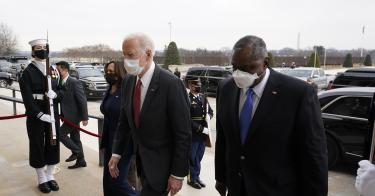As the Biden administration settles in, it is becoming more apparent that their plan for defense is to revive the Obama era’s tried-and-failed strategy of “doing more with less.”
Under the Obama administration, the Defense Department experienced real budgetary decreases for five consecutive years. Those cuts took place while fighting the Islamic State and making fruitless investments in green fuels. The result was that, by 2017, the Vice Chief of Staff of the Army, Gen. Daniel Allyn testified the Army was “out-ranged, outgunned and outdated.” Indeed, every military service was suffering well-documented readiness problems.
Now President Biden seems to be picking up the same playbook of more missions and less money that left our troops in such precarious circumstances.
On March 4, 2021, Secretary of Defense Lloyd Austin sent a message to the Pentagon workforce outlining his priorities for the department. Among the major new missions are to defeat COVID-19 and tackle the climate crisis. Then on March 12, Austin also added: “promoting and protecting the human rights of Lesbian, Gay, Bisexual, Transgender, Queer, and intersex persons around the world” to the Pentagon’s plate.
Four days later, the far-left wing of the president’s party called for a “significantly reduced Pentagon topline.” The group of lawmakers signing onto the letter included only three members with direct oversight responsibility for defense and foreign affairs. The same group earlier called for a 10% reduction in defense spending without any consideration of America’s new strategic environment.
Meanwhile, press reports indicate that the Biden administration is planning, at best, to hold the defense budget flat from this year to the next. In practical terms, it means the Pentagon will lose around 15 billion dollars in purchasing power due to inflation, which averages around two percent a year. As American Enterprise Institution scholar Mackenzie Eaglen recently described the situation: “Two points down in 2020, another two percentage points of loss in 2021, and now a budget that doesn’t keep pace with inflation.”
That is a failing strategy for a military that most believe will be more—not less—important in the coming decade. Just last week, the commander of U.S. forces in the Pacific, Admiral Phillip Davidson, predicted that China could try to attempt to take control of Taiwan by the end of the decade.
It bears repeating that in 2017, as the Pentagon was developing its new defense strategy, shifting defense priorities from counter-terrorism to great power competition, the Secretary of Defense advised it would require spending between 3 to 5 percent above inflation growth for a period of about five years to execute the Pentagon’s mission.
>>> Hits & Misses in Biden’s Interim National Security Guidance
This growth was subsequently validated as necessary by a bipartisan commission evaluating the National Defense Strategy. (That commission included the current Deputy Secretary of Defense.) The ranking members of the House Armed Services Committee recently called upon the Biden administration to adhere to that same growth level.
For Congress to properly exercise its power of the purse, it needs to understand what is necessary to fund the Pentagon’s approved defense strategy. Right now, all the indicators are they will be asked to have more areas of responsibility without any extra resources.
Under Obama, this strategy created a readiness hole from which the military is still trying to extricate itself. Lawmakers should not tell our troops to stay in the ditch and start digging deeper.
This piece originally appeared in RealClear Defense



